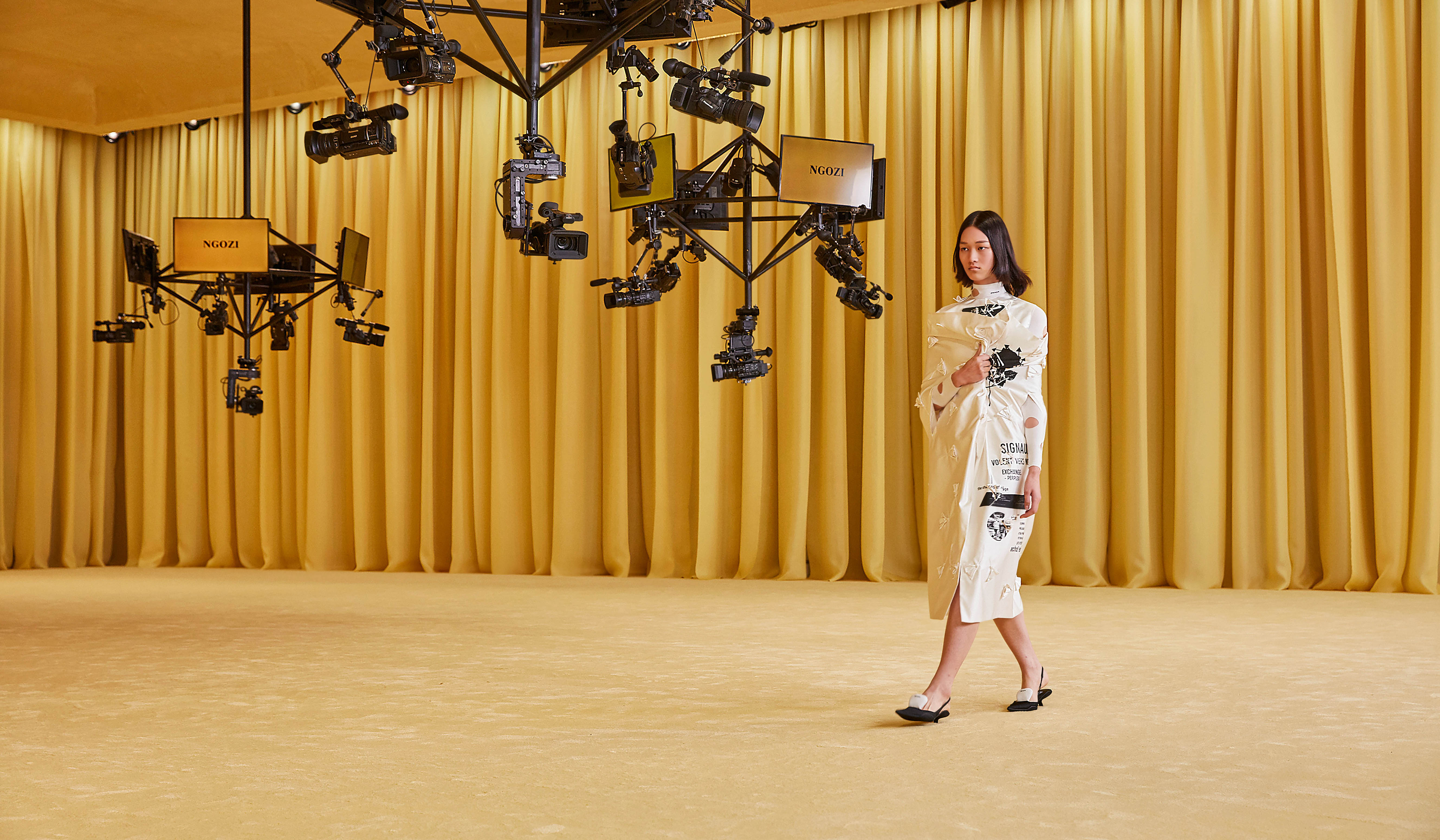At first glance, the setting for Hussein Chalayan’s Autumn/Winter 2000 show was simple. It featured a drab, business-like set: white walls, grey chairs, a TV, a low coffee table. It could have been a waiting room or a conference centre. Each model rounded the set with measured, almost ritualistic slowness, as though pacing the edge of a corporate stone circle. At the finale, four more models emerged and proceeded to unzip the chair covers, which were transformed in a matter of minutes into elaborately structured dresses. A fifth removed the top of the coffee table and stepped inside, pulling the concertinaed layers of wood up around her hips to form a conical skirt. Chalayan’s catwalk magic trick was an instant hit, each transformation eliciting a new round of claps, whoops and whistles from the audience.
The fashion show is a fascinating and often odd enterprise. A trade show masquerading as a mini drama, its raw ingredients are models (usually in motion), clothes (to be sold or used to sell the image of a brand) and onlookers (buyers, press, clients, celebrities, people of influence). Usually it lasts no longer than 15 minutes. This month, an exhibition in Germany’s Vitra Design Museum titled Catwalk: The Art of the Fashion Show explores this curious realm of sartorial pageantry.
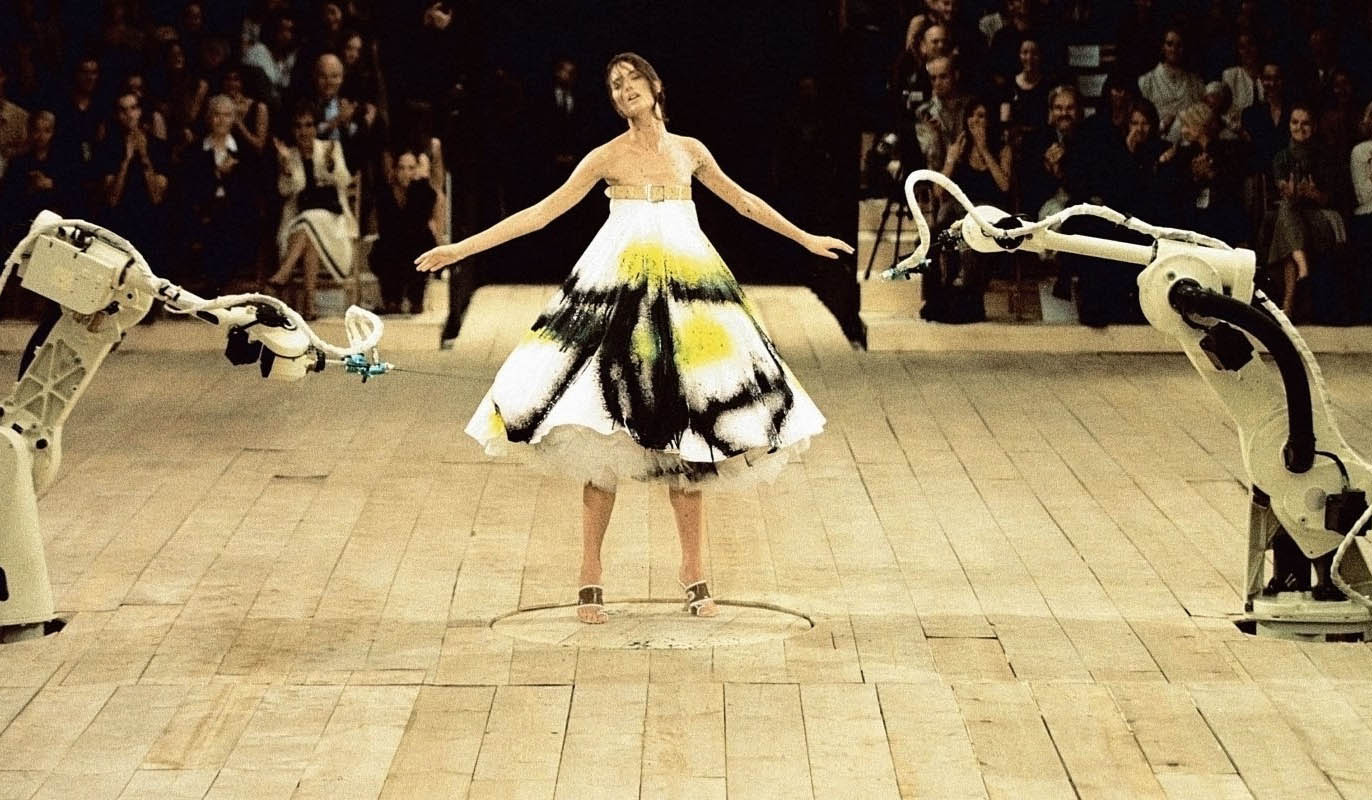
Alexander McQueen SS99 McQueen’s No 13 show, housed in a London warehouse, brought the audience to tears. The late designer was well known for his emotionally charged shows, but Shalom Harlow and the Robots was one of his most dramatic. The show opened with Paralympian and double amputee Aimee Mullins wearing a pair of wooden prosthetic legs created for the event, followed by a cast of 90s models, including Erin O’Connor, Audrey Marnay and Angela Lindvall. As Canadian supermodel Shalom Harlow made her final exit, she stopped between two robot machines. Harlow, a former ballet dancer, began to rotate on wooden turntable as the two robots began to track her movements. The tempo of the music changed and the spray paint attack began. As Harlow swirled, her dress transformed into a living work of art. Jo Jones
The fashion show first came into being in the late Victorian era and flourished in the early 20th century. As fashion academic Caroline Evans writes in The Mechanical Smile, an exploration of modernism, modelling and clothes in motion from the years 1880-1914, her study of the catwalk’s origins. “The fashion show is a nodal point for the convergence of several different histories rarely written about together: those of business, international trade, consumption, women, work and fashion, as well as cinema, revue theatre and visual art.” This has remained true ever since, with the development of established runway practises mirroring not only the extraordinary expansion of the fashion industry as it moved from specialised service to mass production but also its wider relationship with culture.
In the 1950s, salons in Paris hosted a well-heeled clientele who were treated to lengthy parades of possible dresses for them to purchase, all of them buying into a post-war vision of refreshed femininity. In the 1960s, seismic events such as the space race were channelled into the futuristic grandeur of Paco Rabanne and Pierre Cardin’s presentations. And, come the 1980s and 1990s, the rise of the supermodel, exemplified in moments like Versace’s Autumn/ Winter 1991 finale featuring Linda Evangelista, Christy Turlington, Naomi Campbell and Cindy Crawford lip-syncing to George Michael’s Freedom, paved the way for the fashion show to become a form of globalised mass entertainment. At every stage, the fashion show has simultaneously absorbed and shaped the era in which it is staged. This has produced a lot of very boring, inane work. But it has also yielded shows like Chalayan’s, elegantly riffing on millennium urban ennui while also serving as a semi-autobiographical exploration of migration and porous borders, not just between places but between people and things.
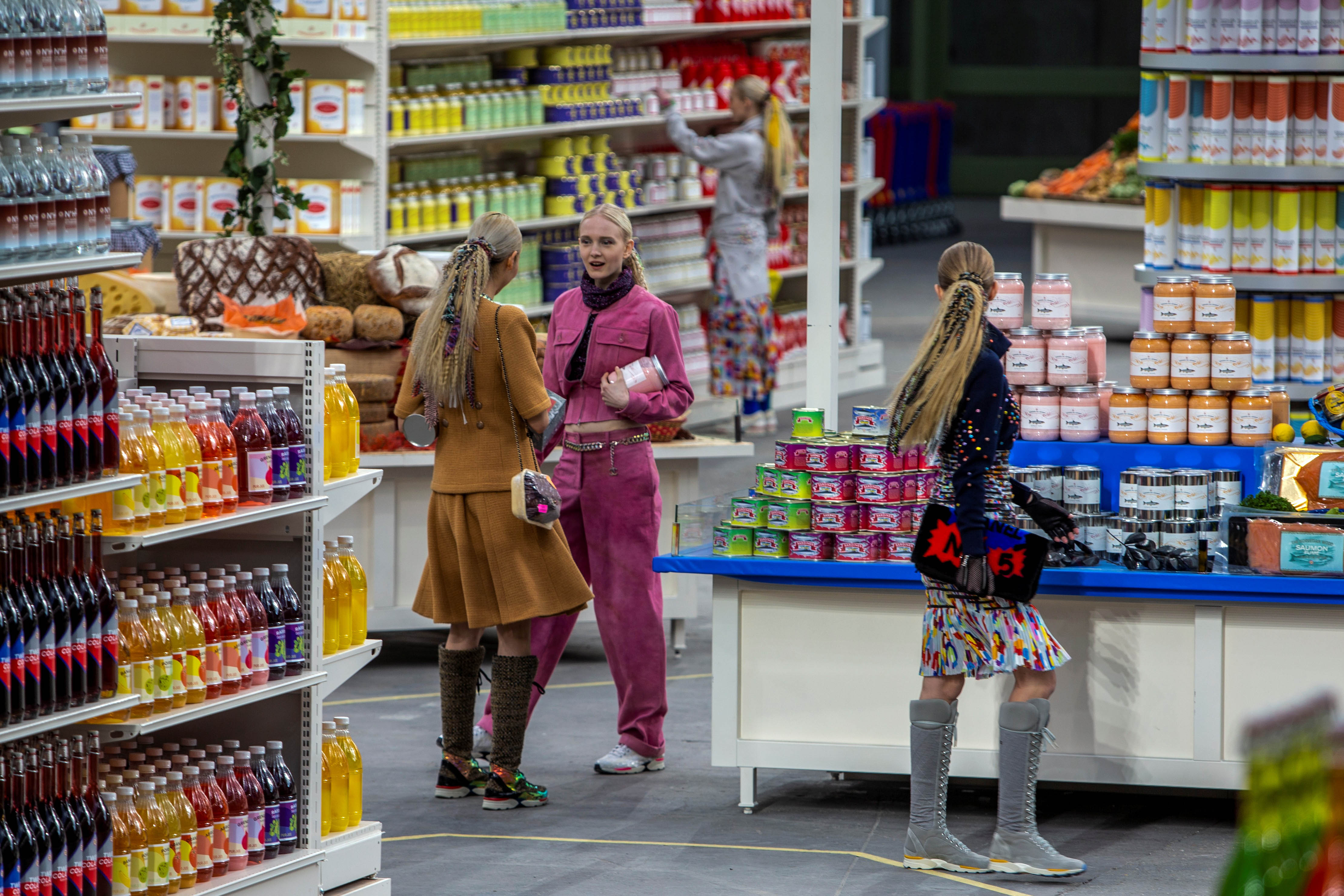
Chanel AW14 Karl Lagerfeld was no stranger to a show-stopping catwalk moment. During his tenure at Chanel he launched a rocket, shipped in an iceberg and built a replica of the Eiffel Tower, but none captured the imagination so much as the Chanel Supermarket. Built for social media, the full-size hypermarché, complete with checkouts and Tannoy announcements was stocked with Chanel-branded products, including ketchup, eggs, cotton buds and, memorably, a chainsaw. Rihanna and Cara Delevingne frolicked in shopping trolleys, models swung Chanel chain-trimmed shopping baskets and everyone went wild in the aisles (quite literally – post show the fashion pack attempted to ransack the shelves for le petit souvenir). Helen Seamons
Today, we are particularly interested in those designers who have pushed the limits of the catwalk format – looking beyond the unadorned runway and into the realm of the enchanting, the enlivening, and the eerie. We call to mind extravaganzas like Thierry Mugler’s 10th anniversary show at the Zénith Paris Stadium in 1984, where he invited 6,000 members of the public to see Pat Cleveland descend from the ceiling as a dazzling Madonna (a sight that the fashion journalist Marion Hume deemed “a brave, deranged declaration that fashion designers, and even ordinary mortals, need not be confined by the gravity of planet Earth”). Or the sheer weirdness of John Galliano’s first major commercial show the following year, in which the model Mimi Potworwska pelted the audience with fresh mackerel. Such moments stick not just because of their novelty or even their star power, but because they add ballast to the argument that fashion can transcend its transactional tethers and acquire a higher meaning, crossing into the realms of theatre or performance art.
In fact, like its static counterpart the fashion photograph, the catwalk is an arena in which the humdrum act of making and selling garments can be transformed into something more narrative. Often, the story remains a simple one. Look at what kind of person you might be if you were wearing this. But the shows we find ourselves most occupied by operate on a more sophisticated level of metamorphosis. Just as a chair is not always a chair, so a show might be a space where clothes are not just clothes. Instead, they are costumes, provocations, necessary elements in a wider dreamscape (or nightmare terrain). In Voss, Alexander McQueen’s legendary Spring/Summer 2001 show, bandage-headed models drifted around a mirrored glass cube as though it were an asylum – Erin O’Connor committing so thoroughly to the part that she bloodied her hands while running them up and down her razor clam dress. As with a number of McQueen’s shows, it registered a deep ambivalence about the fashion industry itself. Before the show started, the mirrored cube reflected back at the audience, forcing them to contemplate themselves. Once it began, they became complicit voyeurs in scenes of distress and ennui.
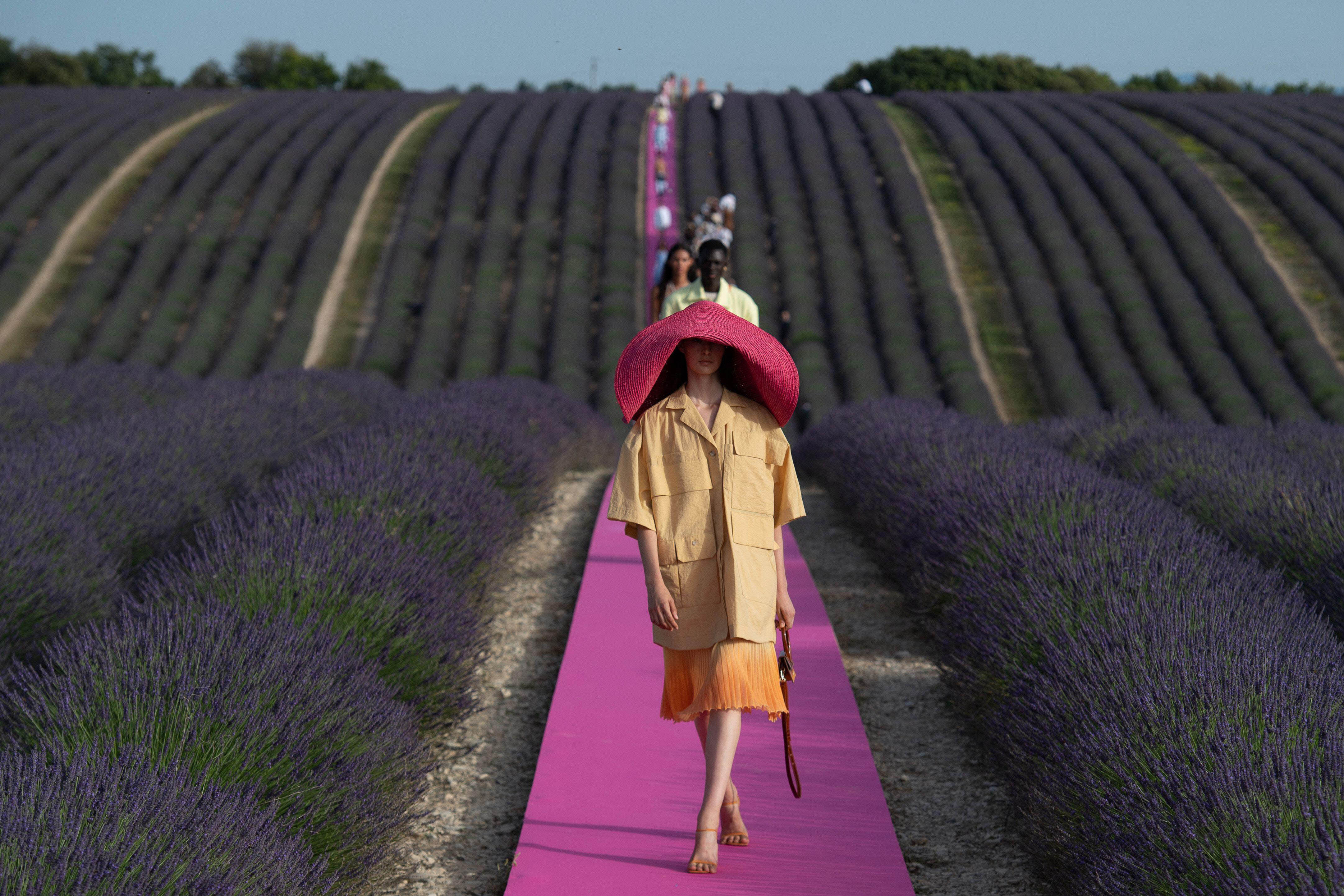
Jacquemus SS20 Held in a dreamlike field of lavender in Provence, French designer Simon Porte Jacquemus’s Spring/Summer 2020 show marked the brand’s 10th anniversary. A front row of iPhone-snapping fashion press, influencers and celebrities bristled with excitement, as models made their way down a mile-long, hot pink runway in oversized tailoring and colourful straw hats. Porte Jacquemus is often pegged as one of fashion’s first designers to realise how powerful Instagram could be when marketing a product, harnessing social media hype with shows like these that went instantly viral. Sam Deaman
“I don’t want to do a show where you walk out and it feels like you’ve just had Sunday lunch,” the designer once observed. “I want you to come out either feeling repulsed or exhilarated, as long as it’s an emotion.”
There are many other strands to the fashion show. Galliano at Dior, Karl Lagerfeld at Chanel and Marc Jacobs at Louis Vuitton are all examples of conjurers par excellence, magicking up a series of grandiose settings: trains, supermarkets, merry-go-rounds. Although the fashion show itself functions as an exclusive destination to which only a lucky few are granted access, with the all-important invite serving as the metaphorical key to the door, its wider use is often to stir as much coverage as possible – especially in today’s frenetic, fickle attention economy where everything is watched, judged – and forgotten in a week.
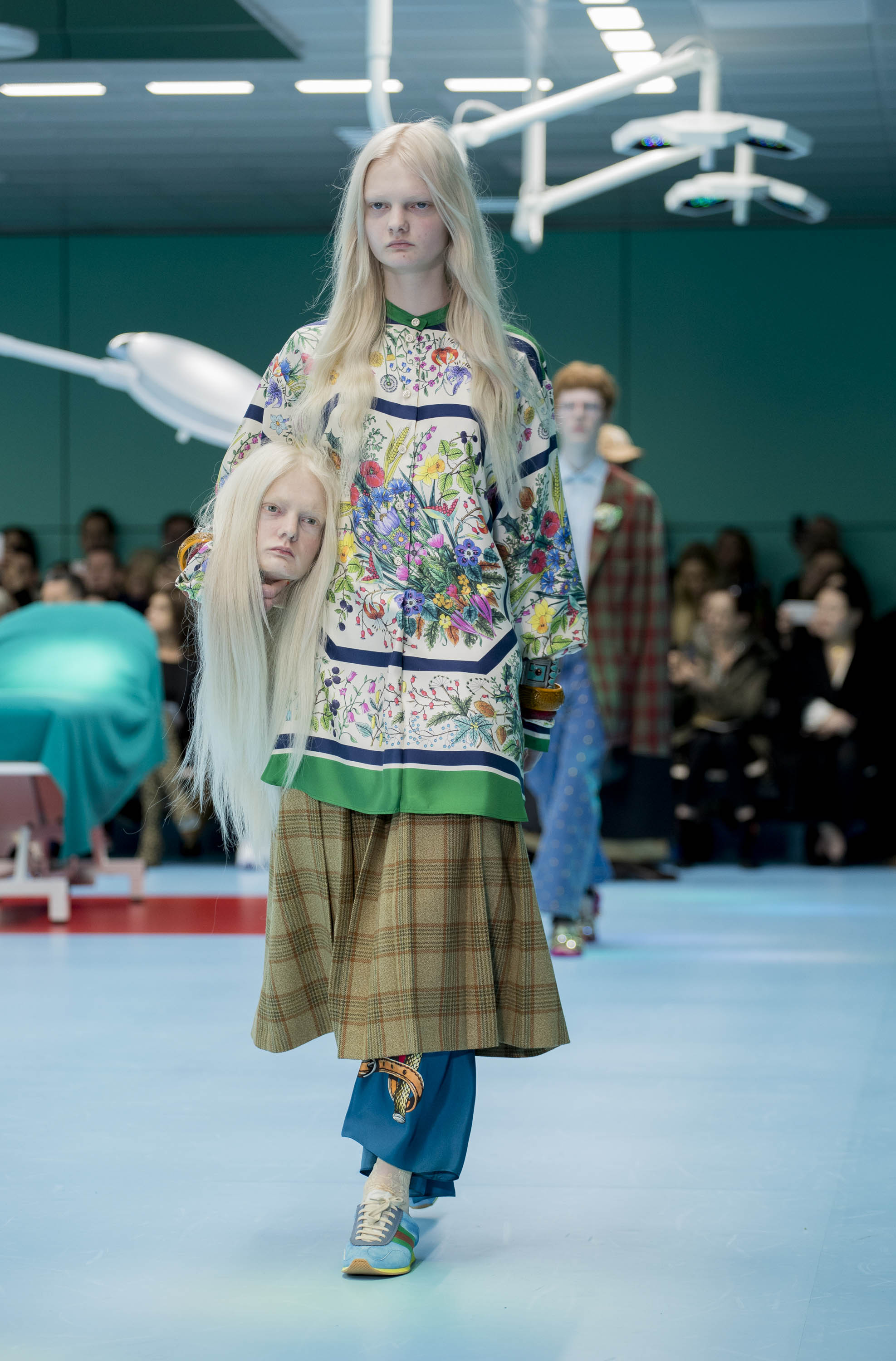
Gucci AW18 Alessandro Michele’s maximalist style transformed the fortunes of Gucci in a few short years. For his 2018 Autumn/Winter offering, he reimagined Milan’s Gucci hub into a surgeon’s operating room, complete with harsh overhead lighting, green panelled walls and plastic waiting-room chairs. With Donna Haraway’s A Cyborg Manifesto as inspiration, models carried lifelike replicas of their own heads down the catwalk, as well as a realistic looking snake, iguana and baby dragon. These otherworldly creations took six months to make in collaboration with Makinarium, a Rome-based physical and visual special effects centre. Sam Deaman
There is a great yearning now for the age of McQueen, Chalayan and other contemporaries such as Martin Margiela, a feeling that their presentations were underpinned by fierce intelligence and a needling willingness to probe at the boundaries of taste and artistry. These weren’t just flights of fantasy but shows that functioned as complex commentaries on the relationship between past and present, probing the recesses of both individual ego and the collective cultural psyche. But even in longing for something sharper and more shocking than anything we find today, we risk falling into what the critic Malcolm Bowie called in 2008, “the machinery of retrospection”, in which the past, flattened into something coherent, becomes a place of safe retreat rather than a spur for fresh ideas.
That said, one of my favourite shows of recent years was not a show at all. During the pandemic, Jonathan Anderson debuted his Eye/Loewe/Nature AW21 collection in the form of a show on a shirt: an oversized T-shirt scattered with pictures of actors Stéphane Bak and Omar Ayuso. I wear mine as pyjamas. I like that it’s a show that isn’t timebound – a living event, worn and washed so often that the colours have begun to fade.
Catwalk: The Art of the Fashion Show is at the Vitra Design Museum, Weil am Rhein, from 18 October to 15 February. It will then tour to the UK and open at V&A Dundee on 3 April 2026
Top image:
Prada SS21 The collection was the first joint effort from co-creative directors Miuccia Prada and Raf Simons, unveiled during the Covid pandemic. Due to travel restrictions, most designers presented their collections digitally. Prada opted for a runway show in film format, followed by an online Q&A. A cast of new models made their runway debuts parading through a plush carpeted set framed with floor-length yellow curtains. Screens and surveillance cameras followed the models, capturing their every move, while providing close-up details for the viewers. Helen Seamons
Picture credits: Prada; Aurore Marechal/Alamy; Kevin Tachmann/Gucci; Robert Fairer; Helmut Fricke/VG Bild-Kunst
